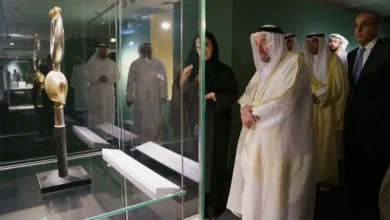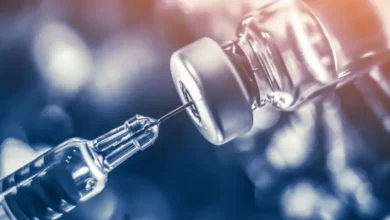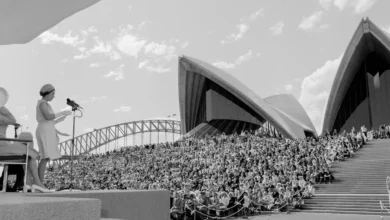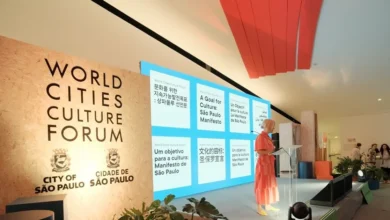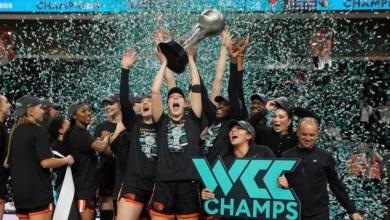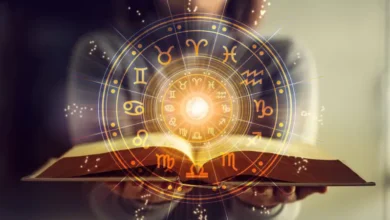‘In the Amazon, protection is spiritual’: Defying coca lords and loggers in the Amazon
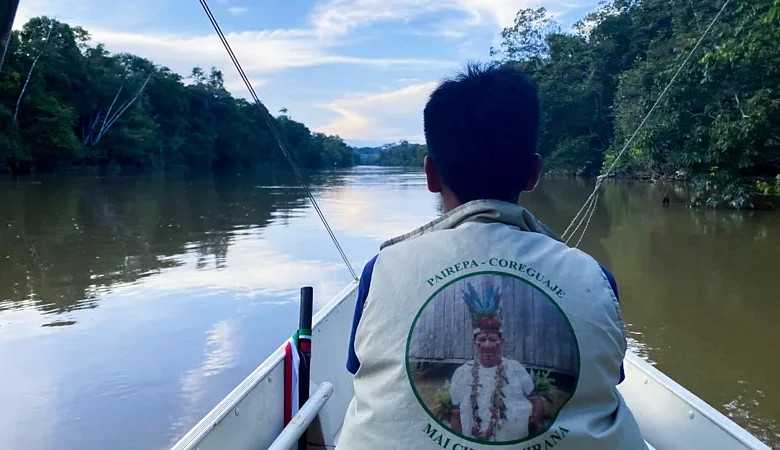
How do you police the world’s biggest tropical rainforest? Faced with deadly violence, indigenous people have set up their own unarmed guard.
Nine nights of sacred ceremonies had passed. It was 2013, and the hundreds of indigenous leaders gathering by the remote Caquetá River in the Amazon rainforest were edging closer to a breakthrough. They had come together in a wooden, palm-thatched meeting house because their communities all faced the same dangers. Scattered across the Colombian Amazon, they were threatened by loggers, poachers and armed groups fighting over control of illegal mining and coca crops, the raw material for cocaine. In this vast and sometimes lawless region, official law enforcement had failed to protect the indigenous people and their forest.
Spurred by rituals and visions from medicinal plants, the leaders agreed to take matters into their own hands.
They decided to form an unarmed guard, following the example of indigenous communities elsewhere in Colombia, who had organised their own peaceful protection. Called the Indigenous Guard for the Amazon, its members would patrol the rainforest wearing a vest with a badge and carrying wooden staffs as symbols of their authority. Despite the dangerous nature of their work, they would carry no weapons.
Today, these indigenous patrols protect rare species, ancient forests, and even the uncontacted communities living next to them. Across Colombia, there are more than 50,000 Indigenous Guards, all with a story bound to the country’s long history of conflict. As the armed groups they face gain more power, the Indigenous Guard’s work becomes more challenging even as it becomes more crucial.

The guards’ work collides with the interests of the ever-more-powerful armed groups seeking to exploit the forests. The NGO Somos Defensores, which tracks the attacks on human rights defenders in Colombia, reported that most of last year’s threats, disappearances, attempted murders and killings targeted indigenous leaders. In total, seven members of Indigenous Guards were murdered in 2024; most of them in Cauca, the south-western region nestled between the Andes and the Pacific. Another was killed in Putumayo, on the other side of the mountains, where the Andes give way to the largest jungle on Earth.
At that founding meeting back in 2013, there was still one detail left to decide: the colour of the banners the guards would tie to their staff. At dawn, a dim rainbow broke over the sky. “Look,” said Luis Jansasoy, a leader of the Inga people, who descend from the Incas. “Here is the flag of the Indigenous Guard for the Amazon.”
Not everyone agreed. Then a second rainbow appeared above the first, brighter, with an energy so intense that, Jansasoy recalls, even sceptics were convinced. “It was such a joy,” he says. “For the first time, our people – especially the youth – could see that the ancestral wisdom and the energy of life are still with us. Many realised that we must not lose faith or hope.”
The Indigenous Guard now exists all over the Colombian Amazon, but it’s not a single, homogenous group. There are more than 60 indigenous communities in the Colombian Amazon, and not all have one. Those that do often adopt their own colours and practices. What unites them is a single purpose: defending the rainforest and all the life it holds.
As global leaders gather in the Brazilian Amazon city of Belém for COP30, the UN’s global climate change conference, we are running a special series exploring this iconic region’s mysteries across different countries.
“In the Amazon, protection is spiritual,” said Patricia Suárez, a leader of the Murui people, whose 12,000 members live along the main western tributaries of the Amazon. Suárez is also an advisor to the Organization of Indigenous Peoples of the Colombian Amazon (Opiac) and to the Colombian government on the protection of uncontacted peoples. She explains that this spiritual protection goes beyond the patrols: for example, she says, the communities’ elders perform dances, songs, and use medicinal plants in rituals that honour and defend the forest from a spiritual point of view.
This spiritual practice is intertwined with the work of the guards who go out on patrol, says Jansasoy. “Our elders, the spiritual guards, put us in harmony and clear the path,” he says.
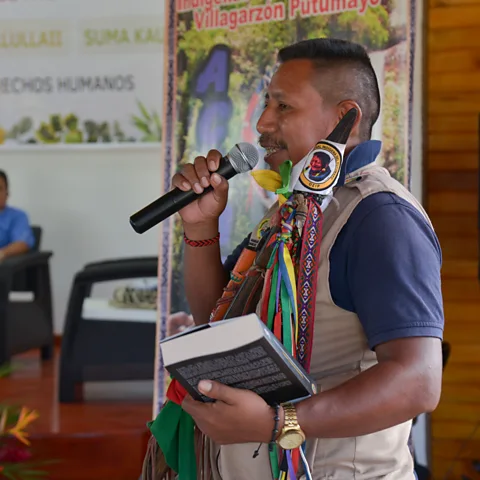
The night before a patrol, the elders and the guards gather for a ceremony that involves drinking yagé, also known as ayahuasca, a sacred brew made from a mix of local plants and shrubs. “The next day, when we set out on our territorial patrols, [the elders] watch over us with prayers to the Creator, so that nothing happens and we can return safely,” he says.
The guards usually move in canoes or on foot in groups of up to 30, never alone. If they spot someone logging, poaching or dredging gold from a river – a process that involves using toxic mercury that contaminates the water – the first step is dialogue, Jansasoy says. The guards explain that the person is in indigenous territories and that what they are doing is not allowed. If that fails, guards report the incident back to their leaders to get more help, and if that also fails, they appeal to Colombian institutions and courts, and may seek help from international allies such as non-profit organisations.
Depending on the community and where they are based, their tasks can range from monitoring and protecting endemic species to safeguarding their uncontacted neighbours, the leaders explain.
Last July, for example, leaders from four indigenous governments, representing more than a dozen communities living downstream from the Caquetá River, convened to coordinate efforts to protect the Yuri and the Passé, two indigenous communities living in isolation. Researchers studying contamination from illegal gold mining had found dangerous levels of mercury in the hair of members of several contacted, non-isolated communities, and there was a concern among the leaders that their nearby, uncontacted neighbours might be facing the same threat – but not know about it.
“We suspect the uncontacted [communities] may be consuming mercury-contaminated fish,” says Suárez, who attended the meeting. “This could be really bad for them, so we want to prevent it.”
The leaders agreed to try and protect their uncontacted neighbours from the mercury, for example, by confronting illegal mining operations and trying to persuade them to stop.
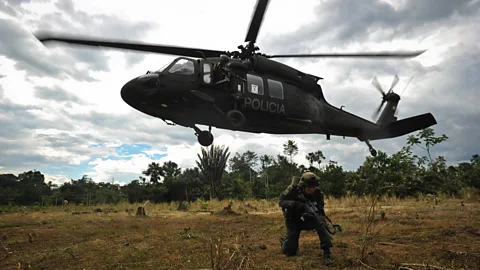
Deadly violence
Protecting the rainforest in Colombia comes with huge risks. Guards often clash with armed groups, which have gotten stronger in the past years, the leaders say, and sometimes are not interested in dialogue.
“There are people with whom you can’t talk,” says Suárez.
But even at times of extreme violence and direct, deadly threats, the guards have continued their peaceful patrols.
Wilmer Becerra was four years old when he fled Puerto Rosario, a resguardo (an indigenous-managed reserve) on the Caquetá River where his family had lived for generations. It was 2003, and the Farc (Revolutionary Armed Forces of Colombia), a left-wing guerrilla army, controlled much of southern Colombia. Some children in Becerra’s family had been recruited by the guerrilla, others disappeared and others were killed.
After receiving direct threats and fearing her son would be forced into the war, too, Becerra’s mother gathered their belongings and left. At the time, the community did not have any way to defend itself. In 2019, as a young adult, Becerra decided to join the indigenous guards.

“My mother instilled in me the ancestral culture,” he says. “Seeing that helplessness our abuelos [elders or grandparents] felt, when they didn’t have anyone to defend them, to stand up for them, also motivates you – so that no one has to live through that again.”
Though Becerra hasn’t faced armed groups directly, a friend was beaten for confronting one. “The armed groups, well, they have their rifles, and we only carry our staff,” he says. “It’s our authority, a shield we carry. But, well, when they want to enter a territory, they simply don’t respect us.”
In 2016, the Colombian government and the Farc signed a peace agreement that was meant to end more than half a century of armed conflict. However, breakaway members of the Farc – some of whom never supported the peace deal, while others laid down arms only to take them up again – continued fighting for control of the country’s illegal economies. A 2025 UN report warned of resurging violence and the recruitment of children in remote indigenous communities via social media. In a separate, recent report, the Defensoría del Pueblo, Colombia’s national human rights agency, found that nearly half of the country’s more than 500 cases of forced recruitment into armed groups in 2024 involved indigenous children.
At the centre of the violence is the fight over the highly lucrative drugs trade, including coca crops, the raw material for cocaine. In the department of Putumayo, which lies in southern Colombia, coca fields have doubled from 25,000 to 50,000 hectares since 2015 – an area roughly 10 times the size of Manhattan. Estimated cocaine production has risen every year in Colombia over the last decade.
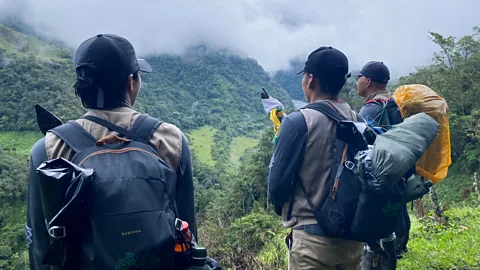
Inner strength
For the guards, preventing the recruitment of their youth and strengthening the social fabric of their communities has become a pressing issue amid these growing external threats.
“The guards are very important because they travel through the territories, seeing what is happening,” says Suárez from Opiac. “But they are also doing a pedagogical exercise, reminding people, ‘We must take care and protect this.’ They strengthen the organisational process of the community and play a key role in communication, passing information from one place to another.”
Mónica Espinosa, an anthropology professor at Universidad de los Andes, says that the guards “allow for the social cohesion of the community”.
Despite the relentless violence, unarmed indigenous guards have been a surprisingly resilient part of Colombia’s history.
The first guards were created by the Nasa indigenous group in the 1970s in Cauca, in south-western Colombia, to reclaim indigenous lands and push for self-governance. Espinosa, the anthropology professor, describes their position in the conflict as one of “active neutrality” – refusing to be drawn into any of the armed groups. Over time, that stance evolved into a practice in which every member serves a year in the guard, “walking the territory and carrying out the tasks of caring for it”, she says, and thereby helping to strengthen the community.
By the 2000s, as the conflict peaked, the Guardia Indígena (Indigenous Guard) was formally established by the Nasa people, and spread beyond Cauca. During that time, in the Amazon, communities also worked on ways to protect themselves, culminating in the nine nights of ceremonies that led to the group’s creation.
“Seeing others with that fighting spirit, that will to resist and defend our traditional authorities… it feels beautiful,” says Becerra.

Protecting the forest
Studies have shown that indigenous territories in the Amazon suffer less deforestation and remain better conserved than surrounding lands. That stewardship has become crucial as the planet heats up. Indigenous guards, constantly patrolling the rainforest, are vital in the efforts to preserve the Amazon’s role as one of the planet’s greatest carbon sinks, a function already imperilled by accelerating forest loss.
“By being present and watching over their territories, indigenous peoples have succeeded in protecting the forests,” says Julia Miranda, a Colombian Congresswoman who directed Colombia’s national parks for 16 years. “Public security forces can’t stay permanently; they come in for operations or patrols and then leave. Instead, indigenous peoples remain. Their presence is constant, not occasional.”
In Jansasoy’s own language, Inga, his title is wasikama – meaning, a guardian of the home. He is also the coordinator of the Indigenous Guard in the department of Putumayo, and as part of his job, he has trained dozens of guards. He has travelled to other communities in Peru and Ecuador to teach first aid, river rescue, disaster response and fire prevention. Guards have also begun forging conservation pacts with their peers across regions. Along Putumayo, upstream communities like Villagarzón, where Jansasoy lives, agreed to keep the waters clean, while downstream communities safeguard the fish swimming upriver and protect animals like tapirs and deer from poaching.
When he goes on patrol, he carries his staff draped in rainbow-colored ribbons and a backpack with a hammock and enough food for up to 20 days in the jungle. On his phone, he still keeps a photo of the rainbow he saw that morning the Amazon guard was created.
“From the Villagarzón mountain ranges to the Amazon, there is a single chain that unites us,” Jansasoy says. “That, along with the river, is what we must care for.”
